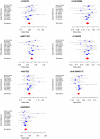A two-stage meta-analysis identifies several new loci for Parkinson's disease
- PMID: 21738488
- PMCID: PMC3128098
- DOI: 10.1371/journal.pgen.1002142
A two-stage meta-analysis identifies several new loci for Parkinson's disease
Abstract
A previous genome-wide association (GWA) meta-analysis of 12,386 PD cases and 21,026 controls conducted by the International Parkinson's Disease Genomics Consortium (IPDGC) discovered or confirmed 11 Parkinson's disease (PD) loci. This first analysis of the two-stage IPDGC study focused on the set of loci that passed genome-wide significance in the first stage GWA scan. However, the second stage genotyping array, the ImmunoChip, included a larger set of 1,920 SNPs selected on the basis of the GWA analysis. Here, we analyzed this set of 1,920 SNPs, and we identified five additional PD risk loci (combined p<5×10(-10), PARK16/1q32, STX1B/16p11, FGF20/8p22, STBD1/4q21, and GPNMB/7p15). Two of these five loci have been suggested by previous association studies (PARK16/1q32, FGF20/8p22), and this study provides further support for these findings. Using a dataset of post-mortem brain samples assayed for gene expression (n = 399) and methylation (n = 292), we identified methylation and expression changes associated with PD risk variants in PARK16/1q32, GPNMB/7p15, and STX1B/16p11 loci, hence suggesting potential molecular mechanisms and candidate genes at these risk loci.
Conflict of interest statement
The authors have declared that no competing interests exist.
Figures
References
-
- Paisán-Ruíz C, Jain S, Evans W, Gilks W, Simón J, et al. Cloning of the gene containing mutations that cause PARK8-linked Parkinson's disease. Neuron. 2004;44:595–600. - PubMed
-
- Valente EM, Abou-Sleiman P, Caputo V, Muqit M, Harvey K, et al. Hereditary early-onset Parkinson's disease caused by mutations in PINK1. Science. 2004;304:1158–1160. - PubMed
-
- Polymeropoulos MH, Lavedan C, Leroy E, Ide SE, Dehejia A, et al. Mutation in the alpha-synuclein gene identified in families with Parkinson's disease. Science. 1997;276:2045–2047. - PubMed
-
- Kitada T, Asakawa S, Hattori N, Matsumine H, Yamamura Y, et al. Mutations in the parkin gene cause autosomal recessive juvenile parkinsonism. Nature. 1998;392:605–608. - PubMed
Publication types
MeSH terms
Grants and funding
- G0901254/MRC_/Medical Research Council/United Kingdom
- G0501560/MRC_/Medical Research Council/United Kingdom
- G0802462/MRC_/Medical Research Council/United Kingdom
- MC_G0901330/MRC_/Medical Research Council/United Kingdom
- G0701075/MRC_/Medical Research Council/United Kingdom
- G0400017/MRC_/Medical Research Council/United Kingdom
- 085475/B/08/Z/WT_/Wellcome Trust/United Kingdom
- R01 NS075321/NS/NINDS NIH HHS/United States
- 089698/WT_/Wellcome Trust/United Kingdom
- R01 NS041509/NS/NINDS NIH HHS/United States
- G-0909/PUK_/Parkinson's UK/United Kingdom
- G1100479/MRC_/Medical Research Council/United Kingdom
- Z01 AG000949-02/AG/NIA NIH HHS/United States
- G0900627/MRC_/Medical Research Council/United Kingdom
- 091157/WT_/Wellcome Trust/United Kingdom
- P30 NS057105/NS/NINDS NIH HHS/United States
- J-0804/PUK_/Parkinson's UK/United Kingdom
- Z01 AG000949/ImNIH/Intramural NIH HHS/United States
- ZIA HG200336/ImNIH/Intramural NIH HHS/United States
- G1100616/MRC_/Medical Research Council/United Kingdom
- F-1202/PUK_/Parkinson's UK/United Kingdom
- G-0907/PUK_/Parkinson's UK/United Kingdom
- G0800784/MRC_/Medical Research Council/United Kingdom
- Z01 ES101986/ImNIH/Intramural NIH HHS/United States
- G0700943/MRC_/Medical Research Council/United Kingdom
- UL1 RR024992/RR/NCRR NIH HHS/United States
- MC_G1000735/MRC_/Medical Research Council/United Kingdom
- 090532/WT_/Wellcome Trust/United Kingdom
- J-0901/PUK_/Parkinson's UK/United Kingdom
- MC_PC_09003/MRC_/Medical Research Council/United Kingdom
- 085475/Z/08/Z/WT_/Wellcome Trust/United Kingdom
LinkOut - more resources
Full Text Sources
Other Literature Sources
Medical
Molecular Biology Databases


